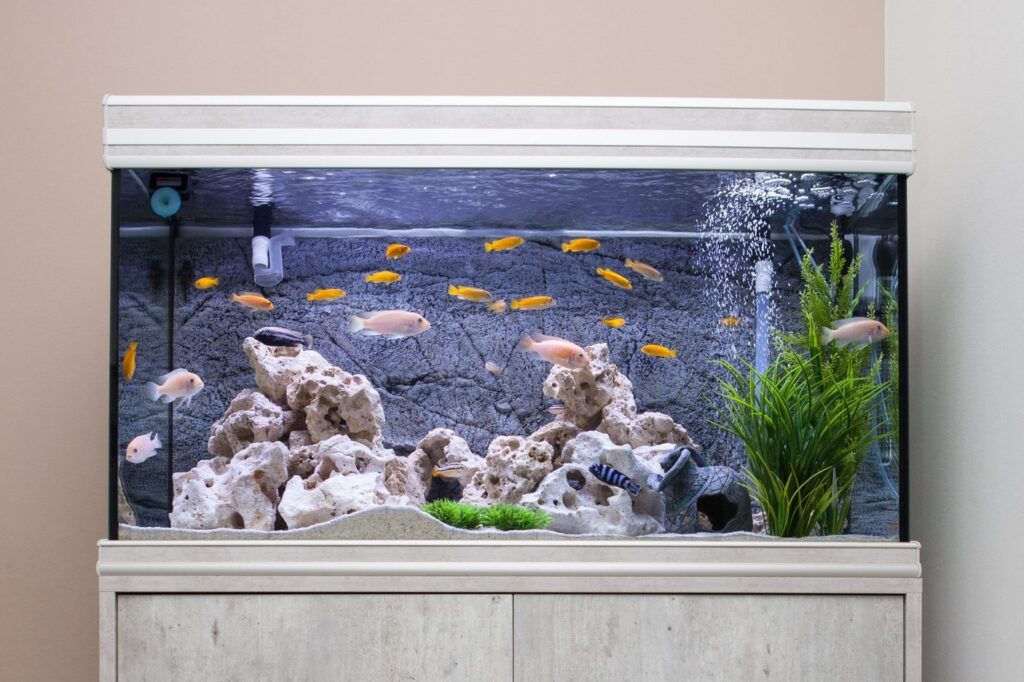
When considering ways to keep your aquarium inhabitants happy, pH levels might not be top of mind. However, dramatic variations in acidity are a definite cause for concern. Fish don’t take well to sudden changes in conditions, and some are particularly sensitive to low or high pH levels.
According to professional aquarist Douglas McComb, stability is the key. “In most circumstances, a neutral or slightly alkaline pH that is stable is the goal,” he says, “and the pursuit of an ideal pH can lead to complications or problems.”
If your tank is testing higher than it should, read on to learn how to safely lower the pH.
While you’re at it, discover the tips to clean aquarium sand and maintain a clean and safe environment for your little friends!
When is High pH a Problem in an Aquarium?
If pH levels are too high, it can cause problems with the natural slime fish have on their bodies to defend against parasites and bad bacteria. And pH levels are often indicators of more influential factors on aquarium health, like carbonate hardness (KH) and general hardness (GH).
McComb says most captive-bred fish you’ll find in big-box pet stores can tolerate the pH levels of typical home aquariums. These tend to be slightly alkaline (7.5 to 7.8).
However, sometimes higher levels can become a problem. Such as:
-
Introducing new fish: If your fish come from an environment with a drastically different pH level from the water in your tank, it pays to gradually add a little tank water to the bag they arrive in. Add a little more tank water every fifteen minutes or so over the course of a few hours so the new fish can adjust. Here’s the list of the best fish for an aquarium.
-
Keeping certain species or wild fish: McComb says wild-caught Cardinal tetras and rummy nose tetras prefer more neutral pH levels. “However, you can condition a lot of wild or near wild fish to higher pH levels,” he says. If your sensitive species are thriving in a slightly more alkaline pH than recommended, it’s often best to leave things as they are.
-
Cultivating specialty planted ‘nature’ aquariums: Some aquatic plants tolerate high pH levels well. However, aquascaping enthusiasts generally want to maintain a slightly acidic level to promote optimal uptake of nutrients when there are lots of plants on display.
McComb recommends standard pH reagent tests available at fish retailers and online. These provide a much more precise measure of levels than paper pH indicator strips. If it turns out to be really low, here’s how to raise pH in an aquarium.
What Causes High pH in an Aquarium?
Without getting bogged down in the complex science, various factors can raise pH levels in your tank water. These include:
Hard tap water
Most commonly, the minerals in hard tap water lead to higher pH levels. However, McComb says that “When you have an established aquarium, with the nitrogen cycle producing acid all the time, you’re not going to end up with a pH of 9.0.”
Water softeners
“A water softener removes only general hardness — the calcium or magnesium components that have no impact on pH,” McComb says. “Traditional water softeners leave behind the carbonates, which are a major contributor to elevated pH levels. So you can still occasionally end up with a tank with high pH, even if your house has a water softener.”
Certain aquarium substrates
Coral gravel is high in calcium carbonate. “This releases carbonates into your water that buffer your pH higher,” McComb says.
“However, in most cases that won’t cause problems unless you have sensitive animals. I actually add coral substrate to some of my aquariums to help keep them stable.”
How To Safely Lower pH
If things are on the high side, try these five expert-approved tips to lower the pH in your aquarium and maintain stable levels.
Use reverse osmosis
“Reducing carbonate hardness by performing a water change with water of a low or zero alkalinity, such as reverse osmosis or even distilled, will ultimately result in a lower pH,” McComb says.
Adding reverse osmosis filters to your whole house water supply, or introducing aquarium-specific filters with high levels of purity to your tank, can remove the tiny hard impurities contributing to higher alkalinity levels.
These filters are a significant investment needing regular maintenance, so they suit serious enthusiasts with the best fish tanks.
Invest in a carbon dioxide injection system
Running a carbon dioxide reactor or diffuser in your tank adds carbon dioxide (CO2) that lowers pH. It offers precise pH control alongside stability for your fish that you don’t get from chemical additives. It also makes nutrients more bioavailable for the plants in your aquarium.
However, McComb says continual CO2 injection in an aquarium with a heavy plant load is a bad idea. Because plants don’t photosynthesize at night, they consume oxygen and release CO2. That can lead to excessive CO2 buildup, causing rapid drops in pH. So always turn off the system when the lights go out.
“Reverse-timer aeration is strongly recommended if you have heavy plant loads, even with a daytime-only CO2 injection regimen,” McComb says. Introducing oxygen bubbles at night through air stones benefits your plants and fish.
Add natural tannins
“Driftwood, Indian almond [catappa] leaves and peat moss all produce tannins that naturally reduce pH and lower alkalinity,” McCombs says. “They can also lower hardness by interacting with calcium and magnesium in your water.”
However, he says, “if you have very high alkalinity, those methods are going to be much less effective.” Plus, they darken the water. While some people appreciate the natural “blackwater” aesthetic, you might not.
Dosage is trial and error. And don’t forget, this method produces slow, minimal changes rather than something big overnight.
Change your substrate
To stabilize rising pH levels, consider swapping out a leeching, calcium carbonate-heavy coral gravel substrate for a more inert type, like sand, traditional gravel, river stone or clay substrate.
Introduce chemical additives
These work, but McComb doesn’t generally recommend them.
While additives rapidly produce an exact pH level in the water, you must constantly and carefully manage the dosing. It’s easy to accidentally trigger a drastic shift in pH that can be harmful, and possibly fatal, to your fish. Plus, the effects are fleeting, and the pH levels can quickly rebound to what they were.
If you use a chemical additive, follow the manufacturer’s instructions carefully to avoid costly mistakes.

